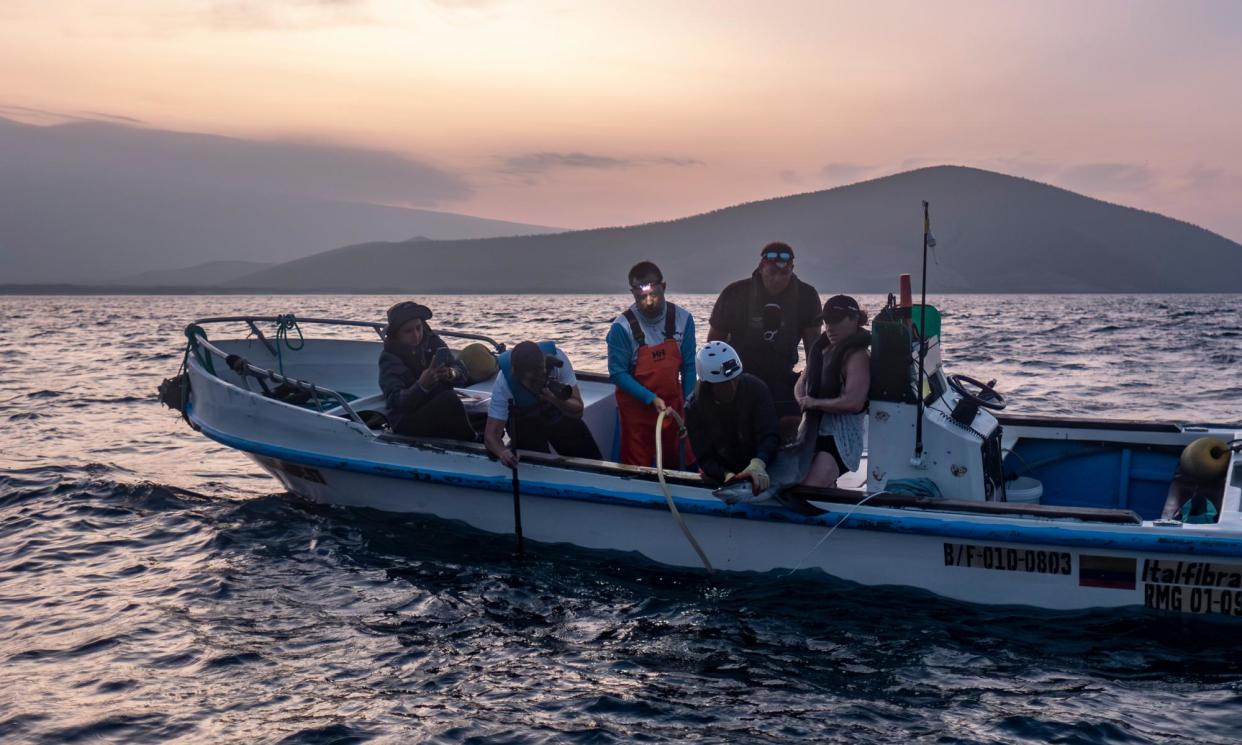‘Where do sharks hang out?’: the race to find safe spaces for the Galápagos’ ocean-going predators

It’s a three-person job to land a 2-metre shark: two to wrap ropes around its thrashing tail and midriff, a third to clamp shut its powerful jaws. Hanging over the side of the Sea Quest fishing skiff, the crew work quickly to minimise any distress to the animal, a female silky shark. Once onboard, a hose attached to a saltwater pump is placed in her mouth, to irrigate her gills.
Catching and tagging sharks is contentious among some researchers, who say it is harmful. But for Alex Hearn, a professor of biology at Quito’s Universidad de San Francisco in Ecuador, who has studied sharks for two decades, it is critical to understanding behaviour that could better protect one of the most endangered group of vertebrates on the planet.
“This looks a bit brutal,” says Hearn, as he picks up a power drill to make the four holes required in the silky’s dorsal fin to attach the tag. “But it’s the most efficient method. Sharks don’t have nerve endings on their fins; what stresses them more is being restrained.”
The shark does not flinch and is back in the waters of the Galápagos archipelago, in the eastern Pacific Ocean, within six-and-a-half minutes. They name her Isabela, after the largest of the islands, 620 miles from mainland Ecuador.
“When we tag these animals to track their movements, we’re building up a picture of underwater highways,” says Hearn, during a two-week Greenpeace expedition to the region in March.
“Are there particular areas they like to hang out? When they move between those areas, do they follow predictable pathways or migratory routes?”
The tightly controlled waters of the Galápagos reserve, a Unesco world heritage site, rate among the world’s top dive spots due to an abundance of hammerheads, whale sharks, turtles and other megafauna. Some researchers believe it has the highest shark biomass in the world.
But once these highly mobile species move outside the reserve, they are vulnerable to overfishing. Despite their endangered status, they are caught and killed in huge numbers by industrial fleets that surround the waters.
For scientists such as Hearn, who want to find out how best to protect them, time is running out.
The world’s shark and ray populations have crashed by 70% over the past 50 years, due to overfishing, a threat compounded by habitat loss and the climate crisis. A third of all shark species, targeted for their fins and meat, and a half of all 31 oceanic sharks, are now threatened with extinction.
Shark fishing, along with the use of long lines, a tuna-fishing technique that results in a high shark “bycatch”, is banned inside the marine reserve. But migratory species that swim outside it and into international waters, can be caught legally.
That is why Hearn and Greenpeace are pushing for additional protections, particularly in the high seas, an area outside national boundaries that is increasingly vulnerable to exploitation.
“The Galapágos marine reserve is not working for highly mobile species,” says Hearn, who co-founded MigraMar, a non-profit environmental organisation involving scientists from California to Chile that maps migratory routes of endangered marine species across the eastern Pacific.
“That’s why we are looking at connecting MPAs [marine protected areas], hotspots and swimways,” he adds.
Hearn’s tracking data from MigraMar shows how threatened marine species, including hammerheads, whale sharks, tiger sharks and turtles, migrate north-east from the Galápagos, towards Costa Rica.
This information helped contribute to the expansion of the marine reserve, by an extra 22,000 sq miles, by Ecuadorian authorities in 2022.
The Galapágos marine reserve is not working for highly mobile species
Prof Alex Hearn
Known as Hermandad (“brotherhood”), the extra protection makes up half of the vital “swimway” used by sharks between Galápagos and the Cocos Island national park off Costa Rica. In half of the protected area there is a complete ban on fishing, while no long-lining is allowed in the other half.
On the bridge of a Greenpeace ship, the Arctic Sunrise, Sophie Cooke, lead investigator for the environmental organisation’s ocean campaign and expedition, points out a map on her laptop showing clusters of industrial fishing vessels around the archipelago.
“You can see what a difference Hermandad has made,” says Cooke, who has collated data from Global Fishing Watch. “When you look at 2019-20 data, you can see there were long liners all around Hermandad. Now, when you look at 2020 to 2022, the long liners have disappeared.”
The next step, says Hearn, is to increase protection for those species that are heavily fished, such as silkies, threshers and blue sharks. “We have a new tool, in the form of the UN global ocean treaty,” he says, referring to the convention governing exploitation of the high seas, agreed by 193 countries last year.
A few weeks after the trip, Hearn tells me Isabela is safe, still swimming in the reserve around San Cristobal where she was found. But the second tagged silky shark, whom the crew named Wolf after another island, did not fare so well. His tag has not pinged a position for two weeks, so Hearn suspects he may have been caught by a long-liner fishing vessel.
Related: MSC orders inquiry into shark finning on tuna vessels in the Pacific
Cooke says Wolf’s disappearance follows a pattern seen in Hearn’s work in 2022, when tagged blue sharks were fished almost immediately. Out of eight blue sharks tagged that year, one was picked up by a Spanish trawler 1,200 miles away near Peru, another was found in an Ecuadorian port, believed to have also been caught, and two were last seen close to the high seas. Three were last seen in the protected area.
“We also saw the blue sharks disappearing after going out to the high seas,” Cooke says. “They are disappearing once they leave protected areas. It strengthens the case that we need high seas protected.”


